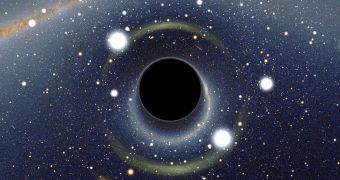For years, experts have been trying to explain how is it that huge plumes of radiation seen coming out of black holes form. Now, new studies are beginning to clear up this mystery, while new spacecraft prepare to launch and confirm the discoveries.
Each of the trillions of galaxies in the known Universe features a black hole at its core. These objects can weigh between 1 million and 1 billion solar masses, and they influence their host galaxies by a significant margin.
In fact, experts believe that the evolution of galaxies and black holes is intimately linked, although how is still a matter of debate. Interestingly, about 1 in 10 dark behemoths is releasing massive jets of plasma from its poles.
These formations can extend through the Universe for millions of light-years, and they have a considerable influence on processes such as star formation in stellar nurseries. This plasma plays a role in regulating how many new, blue stars are ignited in areas surrounding each black hole.
“This black hole in the center of the cluster is affecting everything else in that cluster. Without these jets, clusters of galaxies would look very different,” says postdoctoral researcher Dan Evans.
He holds an appointment with the Massachusetts Institute of Technology (MIT) Kavli Institute for Astrophysics and Space Research. Over the last couple of years, the investigator has been comparing several dozen galaxies and their black holes for clues as to what is causing the emissions.
These objects are called radio-loud active galactic nuclei (AGN), because they light up in the radio portion of the electromagnetic spectrum. Each of the black holes in the study has an accretion disk.
This structure is a ring of material – cosmic dust and hydrogen gas – that revolves outside the event horizon, Friction caused by the spinning of the disk is heating up the material within, and causing it to emit large amounts of radiation.
What Evans is now proposing is that huge emission plumes only occur in black holes which have a retrograde (opposite) spin from their accretion disks. If this is true, then the dark behemoths may truly be playing a tremendously-important role in regulating the growth of some galaxies.
In his newest research, the Kavli Institute expert even proposes an explanation for how emissions are produced in retrograde black holes. He explains that the spin of the object is causing the formation of a gap between the surface of the black hole and the accretion disk.
In other words, the innermost portions of the disk are destroyed. This gap may therefore act like a staging area, where massive magnetic fields interplay, and underlie the force with which the jets are finally released into the surrounding regions, Daily Galaxy reports.

 14 DAY TRIAL //
14 DAY TRIAL //